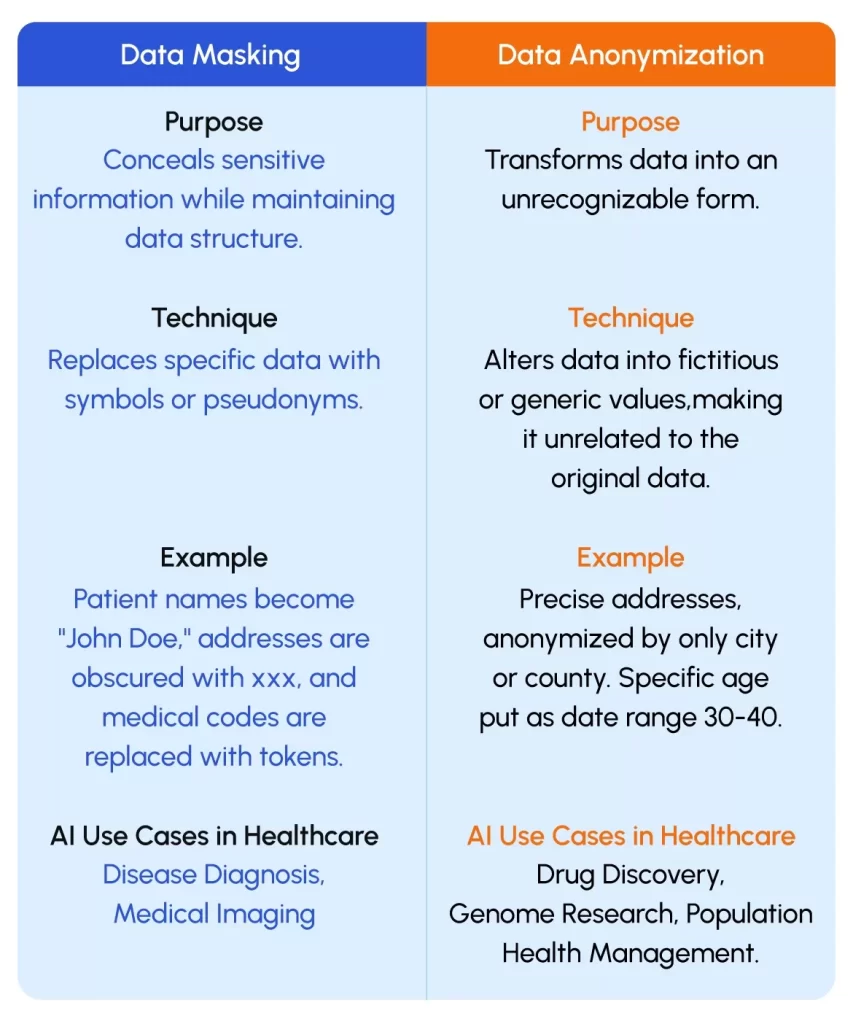The growing use of AI and machine learning in American healthcare raises significant concerns around Personal Identifiable Information (PII). As we pursue innovative healthcare solutions, safeguarding sensitive patient data remains essential. This is where data masking and data anonymization come into play—two critical techniques that are transforming how AI is applied in healthcare.
In the United States, where healthcare data is extensive and varied, it’s crucial to balance advanced medical developments with stringent patient privacy standards, such as those outlined in the Health Insurance Portability and Accountability Act (HIPAA). Achieving this balance is where data masking and anonymization excel.
Here’s a closer look at how these technologies are reshaping AI-driven healthcare solutions while securing patient data.
Data Masking in Healthcare
Technologies Used in Data Masking for Healthcare:
- Tokenization: KAdvanced tokenization algorithms replace specific data elements with tokens or placeholders. For example, a patient’s name might be replaced with a unique identifier, maintaining the data’s structure.
- Format-Preserving Encryption (FPE): FPE encrypts data while keeping its format intact, allowing masked information to remain compatible with existing systems.
- Data Redaction: Redaction tools selectively remove or mask sensitive information in documents, images, or records, keeping sensitive content hidden.
Data Anonymization in Healthcare
Technologies Used in Data Anonymization for Healthcare:
- K-Anonymity: K-anonymity algorithms modify data so that at least k individuals in the dataset share the same attributes, making it difficult to pinpoint any single patient.
- Differential Privacy Differential privacy introduces small, random modifications to data, protecting individual records while allowing for accurate, overall analysis.
- Secure Multiparty Computation (SMC): SMC protocols allow multiple parties to collaboratively compute functions over their inputs without revealing individual data, enabling secure joint data analysis.
Difference Between Data Masking and Data Anonymization
- Data Masking: Imagine you have a patient’s name, “Mike Smith,” in a healthcare dataset. With data masking, you might replace this name with symbols, such as “**** *****.” This keeps the structure of the data but hides the actual name. Data masking is commonly used when sensitive information needs to be shared internally, like with development or testing teams, allowing data to stay protected without altering it for analysis.
- Data Anonymization In data anonymization, “Mike Smith” would be replaced with a completely fictitious name like “Michael Johnson” or “Sarah Brown,” making it impossible to trace back to the real person. This is essential for adhering to strict privacy regulations such as GDPR or HIPAA and is often preferred for data shared with external research teams to avoid legal complications.
In practice, data masking and data anonymization are part of the data preparation stages in AI development to secure sensitive information before datasets are shared with broader teams.

Applications of Data Masking and Data Anonymization in AI-Powered Healthcare Solutions
AI is transforming healthcare by enhancing accuracy, efficiency, and patient care quality. Below are some key use cases where data masking and anonymization protect patient privacy while enabling innovative AI applications:
1. AI-Powered Disease Diagnosis
AI-based diagnostic tools improve the accuracy and speed of disease detection, analyzing clinical notes, medical images, and other patient data. Even smaller medical practices are adopting AI for enhanced diagnostics within Electronic Health Records (EHR) systems to improve treatment recommendations.
Data Masking Techniques
- Pseudonymization: Replaces patient names with unique codes to prevent identification by name.
- Generalization: Broadens specific data points, such as age, into ranges (e.g., 30-40 years).
- Tokenization: Masks specific medical terms or codes (e.g., ICD-10 codes) to maintain confidentiality.
2. AI Integration in Remote Patient Monitoring (RPM)
Remote Patient Monitoring (RPM) enables real-time health tracking outside healthcare facilities, especially beneficial for chronic conditions. AI-driven analysis in RPM predicts health events and personalizes care plans, making it crucial for modern healthcare.
Data Masking Techniques:
- Secure Transmission: Encrypts data in transit (e.g., via TLS/SSL) between devices and servers.
- Data Truncation: Limits transmitted data to essential information, reducing exposure risk.
3. Population Health Management
Health systems, insurers, and public health agencies use AI-driven population health management to track and improve community health. This approach combines vast data sources while safeguarding individual privacy.
Data Masking Techniques:
- Data Aggregation: Raises data granularity to broader levels (e.g., regional) to obscure individual identification.
- Data De-identification: Removes specific identifiers such as names and social security numbers.
Data Anonymization Techniques:
- Differential Privacy: Adds controlled noise to population data, ensuring privacy while enabling useful analysis
4. AI in Radiology and Medical Imaging
AI is increasingly used in radiology to assist with image analysis, enabling quicker and more accurate diagnoses, supporting telemedicine, and advancing healthcare research.
Data Masking Techniques:
- Pixelization: Masks or pixelates non-diagnostic image areas to protect sensitive information.
- Metadata Removal: Strips patient-identifying metadata from DICOM (Digital Imaging and Communications in Medicine) files.
Data Anonymization Techniques:
- Data Perturbation: Adds random noise to image pixel values, maintaining diagnostic integrity.
- K-Anonymity: Ensures each image corresponds to at least “k” individuals, making it hard to pinpoint specific patients.
Schedule a Demo
Learn more about how we protect your data privacy in AI solutions. Our proprietary EHR platform, RehabONE, is deployed in American healthcare and is HIPAA and GDPR-compliant. iTech is also certified in ISO27001, ISO27701, and SOC2 standards, ensuring robust data privacy and security.
Enhancing your workflow through
AI integration is key to future success.
processes and improve efficiency!
I architect and build advanced technology platforms and AI products that drive efficiency, innovation, and smarter workflows. As Co-Founder and CTO at iTech, I lead technology strategy, product development, and innovation across healthcare, energy, A&E, and manufacturing—delivering robust solutions that power 200+ clients and 100+ global businesses.





